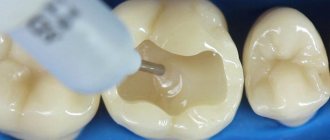Infiltration anesthesia is one of the types of local anesthesia, in which the anesthetic is administered using a syringe into the soft gingival tissue. In dentistry, it is one of the most common, as it can ensure painless dental procedures for sixty minutes or more. Among dental patients, it is called “freezing” because after its administration, depending on the area of anesthesia, numbness is felt in the tongue, upper/lower lip, cheek, oral cavity or part of the face.
Specialists of the dental department of CELT use different types of infiltration anesthesia in the treatment of pulpitis, deep caries, and tooth extraction. The process uses various new generation drugs that have proven themselves well. Their diversity allows you to choose the one for which the patient has no contraindications. The active substances of their composition are quickly eliminated from the body. You can find out the price of infiltration anesthesia in the price list, in the “Services and Prices” section. To avoid misunderstandings, check the numbers with our information line operators or during a consultation with a doctor.
Consultation with a dentist-therapist - 1,000 rubles.
Infiltration anesthesia, conduction anesthesia - 500 rubles.
At CELT you can get advice from a dental specialist.
- The cost of a consultation with a dentist-therapist is 1,000
Make an appointment
Infiltration anesthesia in dentistry
The operating principle of infiltration anesthesia is to stop the nerve impulse that is transmitted from the pulp to the brain. It is manifested by numbness of the treated area: sensitivity is restored as the components of the drug are broken down in cellular tissues. The effect is achieved almost instantly and covers only a certain area, and the drugs used are safe for the human body, since the concentration of active substances in them is minimal.
In order to eliminate the risk of an allergic reaction to the anesthetic in the patient, the dentist conducts preliminary testing. Having individually selected the drug, he determines its dose and injects it into the tissues by injection, following a certain technique. Distributed throughout the cells, the anesthetic stops nervous activity and eliminates pain during dental procedures. It can be entered:
- Under the skin;
- Under the oral mucosa;
- Into the tissue surrounding the bone (periosteum).
Depending on the method of administration, infiltration anesthesia is:
- Direct – targeted introduction into the area that will be subjected to dental procedures;
- Indirect - injection of the entire area adjacent to the pathological focus with penetration of the active components deep into the tissue.
How it goes
Regardless of the area of application of infiltration anesthesia (on the skin or mucous membrane), manipulations are carried out according to the same technique:
- Treating the puncture area with an antiseptic drug.
- Convenient placement of the specialist in relation to the patient (on the right side of the client).
- Exposing the transitional fold of the patient's mouth by pulling back the cheek or lip. The specialist performs the action with his hands or using a special tool.
- Place the tip of the needle on the transitional fold, maintaining an inclination angle of 45° (relative to the alveolar ridge). The bevel of the needle should be directed towards the jawbone.
- Carefully insert the needle all the way into the bone tissue. The immersion depth can be 5-15 mm, depending on the jaw area.
- Inject the drug by applying gentle pressure with your finger on the syringe plunger.
Infiltration anesthesia: application
Indications
- Treatment of pathological conditions of teeth and gums (caries, pulpitis, etc.);
- Removal of teeth of varying complexity;
- Implantation operations;
- Prosthetics;
- Opening the abscess and draining it;
- Removal of tumors on the oral mucosa;
- Surgical dental intervention in the oral cavity.
Contraindications
- Identification of the patient’s individual intolerance to the components of painkillers;
- A pronounced inflammatory process in the oral cavity (anesthesia may not give the desired result);
- The patient has a mental illness;
- Neoplasm of malignant nature.
Contraindications
Infiltration anesthesia is contraindicated:
- If there is a risk of developing endocarditis;
- In the presence of decompensated diseases of the cardiovascular system;
- Patients with artificial heart valves and any other implants;
- During the operation of resection of the apex of the tooth root;
- For the treatment of a patient with marginal periodontitis;
- For multiple tooth extractions and other operations that last more than 30 minutes.
If the attending dentist follows all the necessary technologies for carrying out the procedure, and the patient does not have individual insensitivity to the drug used, then the patient will not feel anything during any dental procedures. The risk of complications during the procedure is very low.
Types of infiltration anesthesia
Classification into species depends on the area of influence.
| Species name | Injection area | When is it shown? |
| Intraosseous | Bone in the area between tooth roots | Removal of one, two, three teeth. |
| Intraseptal | Interdental bony septum |
|
| Intrachannel | Pulp | As an adjunct to intraligmentary anesthesia. |
| Intraligmentary | Between tooth root and bone |
|
| Subperiosteal | The area between the gum and the base of the tooth root |
|
Anesthesia according to Vishnevsky, which combines infiltration and conduction techniques, deserves special mention. It is called “creeping infiltrate” because it stops not only receptors, but also the transmission of nerve impulses along the endings of nerves located in the treated area. An excellent effect is achieved through layer-by-layer administration of the drug: after each stage, the dentist cuts the next layer of tissue with a scalpel. It has the ability to quickly stop bleeding if it occurs and minimizes the risk of damage to blood vessels and nerves.
Other types
There are other methods of pain relief, the principle of action of which is also associated with tissue infiltration:
- “Block field” – appropriate to use in cases where the soft tissues of the jaw are inflamed;
- druk-anesthesia - placing a tampon treated with the drug into the hole resulting from the development of caries;
- plexual - injection into the plexuses of the alveoli (anterior and upper middle part);
- intrapapillary - the drug is injected into the base of the gum papillae located between the teeth.
Pros and cons of infiltration anesthesia
| Pros: | Minuses: |
|
|
Application on the upper jaw
The upper part of the jaw has porous thin tissue; for infiltration anesthesia, this zone is preferable to the lower jaw. After administration, the anesthetic reaches the nerve fibers in a short period of time. Puncture sites are selected depending on the goals:
- to relieve the nerve endings of molars, a needle is placed between the causative tooth and the adjacent molar, the drug is applied to the base of the root;
- when treating incisors, a puncture is made into the transition fold, located slightly above the apex of the roots above the causative tooth;
- For pain relief on the palatal side, a puncture is made into the mucous membrane in the area of the incisor opening.
In the lower jaw, the infiltration method is used for anesthesia during short-term manipulations on soft tissues. If more serious interventions are planned, the anesthesia effect is achieved by combining several types of anesthesia. This approach is explained by the dense structure of the alveolar tissues and low porosity, which creates a certain barrier for the drug to penetrate the nerve bundle.
The anterior section of the lower jaw has the least dense part of the tissue due to micropores, therefore, when manipulating the incisors, the anesthetic is injected into the transitional fold, advancing the needle to the base of the root. To anesthetize all incisors, the needle is placed in the fold between the first incisors. After reaching the tip of the needle at the base of the root, the syringe is positioned horizontally, and when administering the drug, the needle is slowly moved towards the canine. The same procedure is performed on the other side of the lower jaw.
Reviews about our dental therapists
I would like to express my gratitude to the dentist Elena Nikolaevna Kiseleva and her assistant Svetlana - they are real specialists and at the same time sensitive, not burnt out by years of practice.
Thanks to them, I have been coming back here for many years. Thanks to the management for such doctors! Read full review Svetlana Nikolaevna
13.08.2021
I am very grateful to Evgeniy Borisovich Antiukhin for removing my three eights. Especially considering that the lower tooth was not the simplest (it was located in an embrace with a nerve). The removal took place in 2 stages, one tooth under local anesthesia, two under general anesthesia. I had no idea that wisdom teeth could be... Read full review
Sofia
28.12.2020
Precautions and possible complications
One of the possible complications is traumatic neuritis of the facial nerve.
Despite the wide range of applications of infiltration anesthesia, the method can provoke serious consequences:
- hematoma as a result of damage to a vessel by a needle;
- rupture of dental ligaments or tooth deviation due to rapid administration of the drug (the rate of drug administration is 1 ml/15 seconds);
- injury to the nerve trunk, resulting in the development of traumatic neuritis;
- injury to the periosteum, followed by pain and swelling;
- infection due to the use of insufficiently sterile instruments;
- injury to muscle tissue located in the infratemporal fossa;
- blockade of the nerve fibers of the face (the condition is temporary, goes away on its own after a few hours, is recognized by a drooping upper lip and the absence of eye reflexes);
- intoxication of the body due to exceeding the dose or introducing the drug into a blood vessel;
- allergic reaction (redness of the mucous membrane, swelling, difficulty breathing).
To prevent the development of complications, you need to follow simple rules before using the infiltration technique:
- pre-test the drug to identify allergies;
- take a responsible approach to choosing a clinic and specialist; a needle in the hands of an inexperienced or incompetent doctor can cause a lot of problems;
- administer the dosage specified in the instructions; if the drug does not give the desired effect, you need to replace it with another anesthetic drug;
- familiarize yourself with contraindications to the drug and type of anesthesia;
- When administering the product, maintain a calm position so as not to cause injury to soft tissues;
- if the patient is nervous at the sight of a needle, then application anesthesia can be used first.
To prevent the needle from entering a large vessel, the specialist pulls the syringe plunger towards himself when puncturing. The appearance of blood indicates an error. In this case, the needle moves slightly.
Possible complications after tooth extraction
After simple extraction of any tooth, complications occur quite rarely, provided that the doctor’s recommendations are followed.
The main thing is that the patient needs to remember that if the blood clot remains in the socket until healing, then infection and suppuration of the wound will not occur, and within two weeks a healthy gum mucosa will appear at the site of the clot. In case of loss of a blood clot, the unprotected wound surface of the socket is exposed to pathogenic microflora of the oral cavity; the accumulation of pathogenic bacteria provokes the development of an inflammatory process - alveolitis.
Infection of the alveolar socket is the most common complication after tooth extraction. In this case, the infection penetrates and affects the soft tissues surrounding the tooth. If an infectious infection of the hole is accompanied by the presence of throbbing pain and suppuration, this signals the development of an abscess. When alveolitis is advanced, there is a danger of the inflammatory process spreading to the jaw bone - the development of osteomyelitis.
Complex (traumatic) tooth extraction has more prerequisites for the development of inflammatory complications. If after removal there remains a piece of tooth infected with caries, curettage of the hole and extraction of the tooth fragment will be required.
Also, after a complex removal, there is a possibility of delayed bleeding, several hours after the operation. The causes of such bleeding can be high blood pressure, severe stress, the body's reaction to certain medications, excessive rinsing and irritation of the wound with hot food.
In rare cases, the nerve trunks of the lower jaw may be damaged during surgery. Simple or complex tooth extraction is an unpleasant operation, but there is no point in postponing a visit to the doctor if the tooth causes discomfort and pain, most likely its removal is only a matter of time. Modern ultrasonic removal of teeth on the upper or lower jaw will save you from unwanted consequences and many troubles associated with the onset of complications after surgery.
Incorrect position of the wisdom tooth in the row
When a wisdom tooth takes an incorrect position during growth or is partially erupted, pericoronitis (inflammation of the tissues around the tooth) often develops, this is due to the fact that part of the tooth remains in the gum, and the formed periodontal pocket covering the tooth is difficult to clean from food debris , which accumulate and create an environment favorable for the development of pathogenic microflora.
A common disease of wisdom teeth is caries, since food particles remain in the interdental space with the adjacent tooth due to difficult access for cleaning, and plaque forms on the teeth. In this case, carious destruction spreads to the adjacent second molar.
Doctors recommend removing wisdom teeth if they have partially erupted or are incorrectly positioned in the dentition as early as possible, before complications occur and before their roots are fully formed.
Removal of impacted wisdom tooth
Defects in the development of third molars are caused by injury and destruction of the wisdom tooth itself and, if it puts pressure on the adjacent tooth, it damages the roots and surrounding tissues. This situation is observed due to improper growth, damage by caries, often inaccessible to treatment, surfaces of the wisdom tooth with the formation of a focus of infectious inflammation. These complications diagnosed by a doctor are absolute indications for tooth extraction.
This includes the removal of an impacted (unerupted) figure eight, when the tooth failed to erupt and remained embedded in the gum or bone.
Immersion may be tissue if the tooth has passed through the bone but is unable to penetrate the gum tissue, or bone if the tooth remains completely in the jawbone.
Follicular cyst of wisdom tooth
The formation of a follicular cyst can be asymptomatic, but the appearance of pain and high temperature already signals its active development and the presence of an inflammatory process. An increase in the size of a follicular cyst is dangerous due to the thinning of the jawbone tissue due to its replacement with a new growth.
Also, impacted and semi-impacted (partially erupted) figure eights are indicated for removal, since remaining covered by a large layer of dense mucous membrane, they put pressure on the surrounding soft tissues.
Prolonged injury to the mucous membrane from the inside contributes to the formation of pathogenic microflora. The appearance of redness, pain, and swelling indicates the occurrence of an inflammatory process, pericoronitis.
Simple tooth extraction
Simple tooth extraction, including wisdom teeth, is in most cases permissible in the upper jaw, which has a looser and softer structure and allows the tooth to be successfully grasped with forceps. If the tooth has fused roots and can be rocked, then its removal will not be difficult.
Simple removal of a wisdom tooth in the upper jaw can be done with little resistance.
Complex tooth extraction
The anatomy of the lower jaw itself prevents not only the eruption of third molars without complications, but also complicates the process of wisdom tooth extraction.
Difficult tooth extraction from below is due to the fact that the mandibular bone has a denser and stronger structure, and the roots of such teeth in the lower jaw are often curved and may have several processes, which complicates their smooth removal.
Bent or damaged roots of the eighth tooth below or above and its incorrect location, including complete or partial immersion in bone tissue, create a serious obstacle to its extraction. This situation is non-standard and requires labor-intensive efforts to remove wisdom teeth in difficult conditions. To provide quick access to the area where the tooth is located, the surgeon cuts the gum and periosteum.
During such an operation, it is possible to drill out a certain amount of bone covering the tooth or extract the problematic tooth in parts.
Ultrasound removal of wisdom teeth
At the Apex-D Dental Implantation Clinic, wisdom teeth are removed using an ultrasonic instrument.
Ultrasound surgery allows the removal of wisdom teeth, especially in complex cases, in the most atraumatic way.
The use of ultrasound in dental surgery makes it possible to perform surgery in extremely hard-to-reach places, minimize trauma to the soft and bone tissues surrounding the tooth, reduce the likelihood of complications after surgery and speed up the healing of the wound surface of the socket after tooth extraction.
Questions and answers on this topic: Tooth extraction, wisdom teeth removal
You can make an appointment at Apex-D Dentistry by calling the administrator at +7 and +7, or filling out an electronic form (the administrator will contact you at the specified phone number and agree on the date and time of the appointment).
Conduction anesthesia
As for conduction anesthesia, the very essence of pain relief is that the nerve trunk innervating the anatomical zone is blocked with the help of an anesthetic solution. Often this type of pain relief is used to treat teeth in the lower jaw. During the administration of conduction anesthesia, the patient may experience a variety of sensations. It is possible that you may experience a feeling of heaviness, heat or fullness, but this discomfort will disappear in just a few seconds. During surgical intervention, conduction anesthesia ensures a complete absence of painful sensations with a clear consciousness of the patient. From a technical point of view, it consists of a couple of injections of a local anesthetic into the area where the nerve necessary to block sensations is located. For regional anesthesia to work, the drug must be injected into an area close to the nerve. If the anesthetic is injected a little further than the nerve, the expected result will not be achieved, and the patient will suffer pain during the operation. It is necessary to avoid injecting the medicine into the nerve itself, since then undesirable complications of a variety of types may arise. We are talking about a systemic reaction of the body or an allergic reaction. A systemic reaction occurs as a result of accidental, unintentional injection of local anesthetic into a blood vessel. As a result, the patient may experience dizziness, cardiac arrhythmia, weakness and loss of consciousness. As for an allergic reaction, such cases are extremely rare and practically never occur in practice. There are several contraindications . The use of conduction anesthesia is not advisable for patients with infectious and septic diseases, scar tissue and inflammatory vascular diseases. In addition to anesthesia as a drug, during the operation an important role is played by the general calming atmosphere in the office, distracting and relaxing music. Using modern anesthesia, you can tell the patient about the harmlessness of this anesthetic and about its small amount. Patients often respond positively to this information. It is necessary to tell that the patient must be informed about the preservation of sensitivity, so that, if necessary, the dose can be slightly increased. The choice and use of one type of anesthesia is individual, taking into account age characteristics, complexity of treatment and drug tolerance.
Intracanal anesthesia
The intracanal method of pain relief speaks for itself. Typically, intracanal anesthesia in dentistry is carried out in this way: using a drill, a hole is made in the tooth corresponding to the diameter of the needle, and the drug is injected directly into the pulp or deeper into the canal. Sometimes the carious cavity itself is used for this. If we are talking about the intraligamentary technique, then we mean the introduction of a local anesthetic solution into the space at the root of the tooth (periodontal), and the tuberal technique means the introduction of a substance into the posterior alveolar branches of the upper jaw.
Carrying out anesthesia
Since after most dental procedures you should abstain from food for at least two hours, shortly before surgery it would be appropriate to eat followed by cleaning the mouth.
The first thing the dentist does is find out if the patient is allergic to one of the components of the anesthetic. Then local anesthesia (gel, spray) can be applied to the injection area. When the gums become numb, an anesthetic injection is given. The patient should be attentive to the slightest changes in his condition and report them to the doctor. The return of sensitivity in the intervention area occurs after an hour. After this, you can eat (unless the doctor recommends a longer abstinence from food).
Drugs
Articaine-based products are considered effective and safe:
- Ubistezin. Contains epinephrine, a vasoconstrictor that can provide a long-lasting and stable anesthetic effect.
- Ultracaine. Available with or without epinephrine. Epinephrine is contraindicated in patients with diabetes, hypertension, asthma, and anyone who is prohibited from taking medications with epinephrine and epinephrine.
- Septanest. Contains epinephrine and preservatives that are not found in ubistezin and ultracaine.
- Orablock. The drug is similar to ubistezin and septanest.
Novocaine and lidocaine are not used: they are more toxic compared to anesthetics based on articaine. Novocaine, in addition, is powerless against purulent inflammatory processes.








